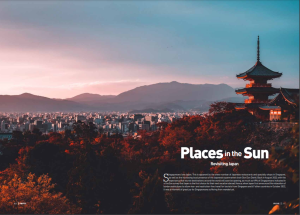
Singaporeans love Japan. This is apparent by the sheer number of Japanese restaurants and specialty shops in Singapore, as well as the increasing local presence of the Japanese supermarket chain Don Don Donki. Back in August 2022, with the expectancy that tourist destinations around the world will soon be opening, as much as 49% of Singaporeans indicated in a YouGov survey that Japan is the first choice for their next vacation abroad. Hence, when Japan first announced the relaxation of border restrictions to allow visa- and restriction-free travel for tourists from Singapore and 67 other countries in October 2022, it was a moment of great joy for Singaporeans suffering from wanderlust.
Japan is not a new travel destination for many of us. However, with three years of international travel restrictions preventing us from visiting the Land of the Rising Sun, some of us may find our memories of Japan to be just a little faded. In this article, we hope to jog your memories on the unique charms of Japan, specifically the cities of Shizuoka, Nagoya, Kanazawa, Kyoto and Osaka.
CHŪBU AND KANSAI Three of the cities (Shizuoka, Nagoya and Kanazawa) featured in this article are in the Ch bu region, while the other two (Kyoto and Osaka) are located in Kansai. We will start this tour of Japan from Chūbu.
In terms of direct flights, while there are a number of flights serving Singapore and Osaka (Kansai International Airport), it is more common to access Chūbu from Tokyo’s Haneda and Narita airports. From these airports, a ride on the Shinkansen (via Tokyo Station after a ride on Narita Express from Narita Airport, or via Shinagawa Station after going on the Keikyu Airport Line serving Haneda Airport) is the fastest way to get into the Ch bu region. The cities of Shizuoka and Nagoya are located near the southern coast, while the city of Kanazawa is over at the northern coast. We will start from the south.
SHIZUOKA
The Shizuoka prefecture is famous for several things in Japan. Its main calling card is Mount Fuji, the tallest mountain in Japan and arguably the country’s most famous landmark. Shizuoka also boasts the largest production of green tea in the country. However, even though the capital city of Shizuoka often gets its thunder stolen by the magnificence of Mt Fuji, there is still plenty to discover in this less-visited city.
Compared to the gargantuan, bustling busyness of Tokyo, the quaint city of Shizuoka offers a peaceful respite from metropolitan madness. It has an old-world, small-town charm you will not find in larger cities. Centred around Shizuoka Station, the city is one that is steeped in history. Shizuoka was the home of Tokugawa Ieyasu, the founder and first shogun of the Tokugawa Shogunate of Japan. Remnants of his rule are still prominent in Shizuoka, the most famous of which is Sunpu Castle – the home of Ieyasu.
Sunpu Castle is a mere 15-minute walk away from Shizuoka Station. It is a good starting point for your tour of Shizuoka. While the original castle was torn down and subsequently destroyed in an earthquake close to a century ago, many of its structures, gates and turrets have been lovingly reconstructed in recent decades. The castle is encompassed within the beautiful Sunpu Castle Park.
Inside the park, which is famous for its cherry blossom trees, you can take a relaxing stroll in the beautiful environment. During the cherry blossoms season in February, you will see scores of locals picnicking and enjoying the beautiful sight of the Sakura. The park has a beautiful little garden called Momijiyama Garden (located near the castle) which features a mound of soil piled up to resemble Mt Fuji. Located beside the Momijiyama Garden is a tearoom where you can sample a cup of Shizuoka’s finest green tea while taking in the picturesque and tranquil surroundings. Spend an hour or more in Sunpu Castle Park before making your way to other attractions in the city and beyond.
From Sunpu Castle Park, make your way back to Shizuoka Station and take a 20-minute ride down the JR Tokaido Line to the town of Shimizu. While Shimizu might appear to be no more than a small fishing town, there are plenty of pleasant surprises to be unearthed here. For starters, Shimizu Station is located within walking distance of Shimizu Fish Market, where there is a treasure trove of family restaurants (on the second floor) offering the freshest seafood at knock-down prices. Have your pick and fill of the best seafood that Shimizu Port, which has one of the largest tuna hauls in Japan, has to offer.
Once you have had your fill of fresh seafood in the fish market, you can take a quick tour of the nearby Shimizu Cultural Centre. You may then take a limousine bus ride near Shimizu Station down the main road to the S-Pulse Dream Plaza. Alternatively, if you are in the mood for a healthy walk after a good meal, follow the main road down to the Dream Plaza. It is a comfortable 15 to 20-minute walk.
S-Pulse (which is also the name of the local J-League football team: Shimizu S-Pulse) Dream Plaza is the main shopping complex in Shimizu. It offers a variety of restaurants and shops specialising in local produce and souvenirs. Here, you can have your fill of the best seafood that Shimizu (and indeed, Japan) has to offer, while shopping for local delicacies to bring back to Singapore. Keep a look out for dried Sakura shrimps. While they are pretty expensive in Singapore, they are dirt-cheap in Shimizu, where they are a specialty produce.
If you have more time to spare in Shimizu, take a (25-minute) bus ride on the Shizutetsu bus bound for the Tokai University Miho Aquarium to visit Mihono-Matsubara Pine Grove and Miho Beach, a hot spot for windsurfing, fishing and more during summertime. Miho-no-Matsubara is a 7km stretch of coastline lined with pine trees. It has been touted as one of the Three New Views of Japan , alongside Ōnuma in Hokkaidō and Yabakei in Ōita. Designated as a UNESO World Heritage Site, Miho-no-Matsubara offers a breathtaking view of Mt Fuji.
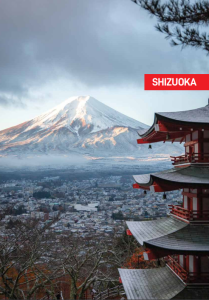
NAGOYA
About an hour ride away on the Shinkansen from Shizuoka, Nagoya is the fourth most populated city in Japan and the largest in Chūbu. With a level of buzz that parallels Tokyo, Nagoya has much to offer in terms of both historical and urban attractions. Try to secure accommodation within walking distance of Nagoya Station, one of the largest train stations in the world by floor area and one of the major transport hubs in Japan; you will have much easier access to attractions in the city.
One of the first places you should visit when you set foot in Nagoya is the towering Nagoya Castle, arguably the symbol of the city. Famous for sporting a pair of golden shachihoko statues on the top of the tower, Nagoya Castle was – like a number of other famous castles in Japan – reconstructed in recent decades, after the original building was destroyed during World War II. Nagoya Castle is a 25-minute walk away from Nagoya Train Station, but a quicker route to get there is by taking the Higashiyama Line and transferring at Sakae Station (two stops) onto the Meij Line to Shiyakusho Station.
The towering, reconstructed castle is magnificent, and holds a number of historical exhibits and art pieces. These exhibits tell the stories of lives lived within the castle centuries past. During weekends, there are also performances by costumed samurais who offer unique photographing opportunities. Do not hesitate to approach them for a picture together or a chat about the castle.
Adjoining the castle is the beautiful Meij Park, which was once part of the castle grounds. Here, you will find local families enjoying themselves picnicking or playing games. This is especially so during weekends, and during summer, autumn and New Year festivities. Besides Meij Park, you will also find the Aichi Prefectural Gymnasium in the vicinity. This venue hosts many major events, including the annual Nagoya Sumo Basho, one of only six annual grand sumo competitions in Japan.
If you fancy yourself as a bit of a museum buff, there is a variety of choices in Nagoya to satiate your curiosity. Start with the Nagoya City Science Museum, where you will get to see interesting exhibits centred around various sciences and visit the world’s largest planetarium. The museum is a five-minute walk away from Fushimi Station, which is one stop down the Higashiyama Line from Nagoya Station.
On the other hand, if you fancy yourself as more of an art buff, take a visit to the Tokugawa Art Museum located within a 15-minute walk from Ozone Station (take the JR Chuo Line from Nagoya Station).
Tokugawa Art Museum was established in 1935. It houses the most extensive collection of samurai artifacts from the most
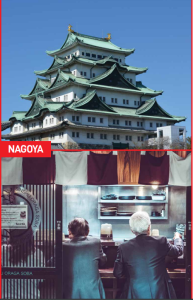
senior of the three sub-houses of the house of the Tokugawa Shogunate. The core of the collection was donated by the Tokugawa clan and includes a number of priceless art pieces, furnishings and heirlooms. The jewel in the crown is arguably “The Tale of Genji” – the oldest extant novel in the world, which has origins from the early 12th century. It is one of 10 designated National Treasures in the museum and is not on permanent display. Besides “The Tale of Genji”, you will also get to see a fine collection of swords, armour, Noh costume and lacquer. One of the permanent collections in the museum is the Symbol of the Warrior, a series of exhibits which focuses on the ways of the samurai.
After getting a taste of the history of Nagoya, it may be time for some shopping! You will have no shortage of shopping choices in Nagoya. If you are based around Nagoya Station, you can start your shopping spree at the station itself. If you have been to Japan before, you will know that the larger train stations almost invariably have department stores located within the compound. Nagoya Station is no exception.
As one of the world’s largest train stations in the world, Nagoya Station has a wide variety of great shopping choices housed within the adjoining JR Central Tower and the JR Gate Tower. Here, you will find the familiar Takashimaya Department Store. Spread over 13 floors, with the B1 and B2 levels dedicated to a supermarket and cooked food vendors, this megastore offers a huge variety of international and local brands for you to choose from. Meanwhile, Level 12 houses a Restaurant Street where you can pamper yourself to a great meal after an exhausting shopping spree at the other levels.
Besides Nagoya Station, there are also other great shopping choices around the area. This includes Midland Square which features a huge movie theatre and a number of international luxury brands like Louis Vuitton, Loewe and Chloe.
Venturing slightly further away, you can go to the Sakae shopping area – Nagoya’s main shopping and entertainment district spread across the Sakae and Yabach Stations. Sakae is a buzzing shopping hub. It features a good mix of department and high street stores, including big names like Mitsukoshi, Lachic, Parco, Maruei and Skyle. Most of these stores are located along the main street between Sakae and Yabach Stations. While you are at the end nearer to Sakae Station, you may also want to drop by Oasis 21, a futuristic looking complex housing Nagoya’s highway bus terminal and the Mirai Tower, Japan’s oldest TV tower and a symbol of the Sakae district.
Finally, if you are looking out for a quintessential Japanese shopping experience, drop by the Osu shopping area, which is centred around the Osu Kannon. To get here, make your way to Osu Kannon Station by taking the Higashimaya Line from Nagoya Station to Fushimi Station, then change to the Tsurumai Line.
Here, you will find shops dedicated to the Japanese otaku culture, little quirky shops and even a flea market near the Osu Kannon. The market is usually held on the 18th and 28th of every month. While you are here, do drop by the Osu Kannon as well. This striking red temple is an oasis of calm and tranquility in a city that is always buzzing with activity.
As a reminder, do remember to apply for tax refunds for your purchases at the store on the same day (where applicable) wherever you are in Japan.
KANAZAWA
Kanazawa is a destination that is not often favoured by Singaporeans as it is not heavily publicised as a tourist spot. The city is located on the northern coast of Japan in the Ishikawa prefecture. To get to Kanazawa from Nagoya, you can either take the direct JR Shirasagi Limited Express Train (which is available every one to two hours) or if you want to experience travelling in a different way, take the highway bus. It is a longer but cheaper route of travel (three and a half hours).
Arriving at Kanazawa Station, you will be greeted by the sight of a futuristic station with a glass and steel dome that features subtle shades of gold and traditional decoration. Walking outside the station, you will see the huge and beautiful Tsuzumi Gate. The impressive gate was built with Japanese Douglas fir and designed to look like a tsuzumi, a traditional drum used in Noh performances. Kanazawa Station is widely considered to be one of the most beautiful train stations in Japan, and the Tsuzumi Gate offers a unique picture you will not get anywhere else.
The obvious starting point for sightseeing in Kanazawa is Kenrokuen Garden, one of the Three Great Gardens of Japan, alongside Kairakuen Garden in Mito and K rakuen Garden in Okayama. These gardens were built by feudal lords during the Edo period (1603-1868). Kenrokuen was developed and perfected by the Maeda clan, who ruled the Kaga Domain, for a period of 180 years from the year 1620. The garden was opened to the public in 1874 and was designated as a National Site of Scenic Beauty in 1922. The garden was upgraded as a National Site of Special Scenic Beauty in 1985. This designation gives it a status equivalent to a National Treasure.
In Japanese, “Kenrokuen” means “the garden which combines six characteristics”, which include the following: spaciousness, seclusion, artifice, antiquity, water resources and magnificent views. Thus, you can expect all of the above in this huge 11.4-hectare garden. Kenrokuen is not located near to the city centre, even though it is easily accessible by bus from Kanazawa Station (take the Kanazawa Loop or the Kenrokuen Shuttle). The journey from the train station to the garden takes about 15 minutes.
Once you reach the garden, it is easy to see why Kenrokuen is so highly regarded in Japan. Kenrokuen has all the best features of a typical Japanese garden: ponds, stone lanterns, waterfalls, stone paths, bridges, streams, tea houses and artificial hills. No matter the season, the beauty of the garden is accentuated through different aspects.
During springtime, the bloom of the cherry and plum blossoms brings glowing picturesque life to the garden. In the summer, the garden’s intense greenery and the blooming of other flowers, such as azalea, breathes new life into the garden. Breaking into fall, blazing red maple leaves turn Kenrokuen into the most achingly beautiful scenery you will ever see. With winter, the snow-covered pine trees along the pond offer an unparalleled ethereal and romantic view. Kenrokuen is simply a place for all seasons!
While you are at Kenrokuen, pay a visit to Kanazawa Castle, which is located next to the garden. Kanazawa Castle is located in Kanazawa Castle Park, which adjoints Kenrokuen. It is a partially restored castle, which used to be the headquarters of the Japanese Army during the Meiji era. Inside the building, you will find intricate displays and models of the castle highlighting the various techniques used to restore the monument.
If you have time after visiting Kenrokuen and Kanazawa Castle, you may want to take a 20-minute walk to the Higashi Chaya District – the largest of three well-preserved historical geisha districts in Kanazawa. Wander through the historical townscape of the district and visit a traditional teahouse while you are here.
You will also find plenty of gold leaf galleries which can offer you a hands-on experience creating your own gold leaf design. Gold leaf is a Kanazawa specialty, with 99% of the country’s gold leaves made in this city. There is even a museum (Kanazawa Yasue Gold Leaf Museum) where you can see articles collected by Komei Yasue, a celebrated gold leaf artisan, including gold-beating tools, folding screens, Noh costumes and Kutaniyaki ceramics.
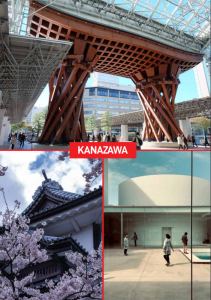
After having your fill of Kanazawa’s history, it is surely time to fill your stomach. Omicho Market, one of Ishikawa prefecture’s top seafood markets, is the place to start. Fresh seafood is delivered to the market from the Sea of Japan on a daily basis. This sprawling market bustles with activity in the morning and afternoon, with locals and curious tourists filling the aisles to the brim.
Make your way around the market for a look at the wide variety of seafood and other fresh produce on sale. Once you are done with your tour, settle in at any one of the many grilled seafood/ sushi restaurants/stalls dotting the perimeter of the market for a good meal. Many of the open-air stalls offer seafood meals at dirt-cheap prices. You will be spoilt for choice!
As the final part of your stay in Kanazawa, you may want to take the Noto Coastline Sightseeing Bus to the Ganmon Sea Cave. The Ganmon Sea Cave is located along the coastline of the Sea of Japan. Here, the constant beating of the rough seas has resulted in a dramatic coastline made out of unusual rock formations. The Ganmon Sea Cave is located next to the Ganmon Gate Rock, a large cliff formation jutting out into the water, with a giant hole in the centre carved out by erosion. You can explore the cave by taking a footpath and a flight of steps that take you into a tunnel. Spend an hour exploring the cave and observing the little sea creatures scuttling around.
KYOTO
From Kanazawa, Kyoto is accessible via the Thunderbird Limited Express train. The journey takes about two hours. Kyoto Station is one of Japan’s largest train stations and offers a huge variety of shopping and dining choices within the building itself. In fact, Kyoto’s second largest shopping area is based around the station. At the station, you will find the Porta underground shopping mall and the CUBE (with Isetan), while Aeon Mall Kyoto as well as major electronics retailer BIC Camera are also nearby. In terms of attractions, the station offers access on foot to Toji Temple, the Nishi Honganji Temple (both are World UNESCO Heritage Sites), the Kyoto Aquarium and the Kyoto Railway Museum.
Toji Temple is a 15-minute walk away from Kyoto Station, but if you do not wish to walk, you can take a train to Toji Station (take one stop down the Kintetsu Kyoto Line from Kyoto Station). The temple is located next to the station. It was founded during the beginning of the Heian period in the late 700s when Kyoto was the capital city of Japan and is over a thousand years old.
The Kondo Hall is the temple’s main hall and largest building. It houses Toji’s main object of worship, a wooden statue of the Yakushi Buddha, flanked by the Nikko and Gakko Bodhisattvas. Next to the Kondo Hall stands the Kodo Hall. The building houses 19 statues arranged according to a mandala with the Dainichi Buddha in the centre, surrounded by Buddhas, bodhisattvas and guardian kings. Across from the Kondo and Kodo Halls stands a five-storied wooden pagoda. At 57m, it is the tallest wooden pagoda in Japan. It is seen by many as a symbol of Toji Temple and of Kyoto itself.
After a visit to Toji Temple, you may also want to drop by Nishi Hongganji, which is located around the vicinity as well as the Kyoto Aquarium and the Kyoto Railway Museum, which are are located at different parts of the nearby Umekoji Park. Following which, walking a little further towards Shijo Avenue will lead you to Kyoto’s famous Nishiki Market.
Known as “Kyoto’s Kitchen”, Nishiki Market is a narrow shopping street with hundreds of shops selling all manners of foodstuff, including Kyoto specialities like sweets, pickles, dried seafood and tea, as well as other products like knives and cookware. Nishiki Market has existed for several centuries, and is very well-known throughout Japan and the world. Many of the shops here are operated by the same families for generations.
While it is a lot more convenient to get to Nishiki Market from the nearby Shijo Station (take the Karasuma Subway Line from Kyoto Station), it is actually within manageable walking distance from Kyoto Station. The best time to visit Nishiki Market is usually in the mornings when the place is absolutely buzzing with activity. It is a great place to do your shopping for Japanese goodies to bring back to Singapore. You can also taste and sample local delicacies at affordable prices, including skewers and sushi.
If you fancy a walk to burn off some calories after a good meal at Nishiki Market, you may want to walk your way down to Gion by walking along Kyoto-Kawaramachi. Be warned that the walk is somewhat “distracting” as there are many shopping centres and smaller shops that you will probably end up going in to browse or shop. Shijo is the city’s largest shopping district and it does not disappoint. You will find well-known department stores like Takashimaya and Daimaru here as well as luxury brands like Louis Vuitton.
As you make your way towards Gion and the famous Kamo River, you will notice the huge big-name stores increasingly giving way to smaller shops selling fashion, foods and craft. The prices at these smaller shops, especially for snacks, are usually cheaper than what you see in the department stores. So, fill up your suitcases with many uniquely Japanese snacks at Shijo!
Crossing over to Gion from Shijo requires a walk across a bridge over Kamo River. While you are here, do take a climb down to the riverbanks of Kamo, a popular place for many locals. You will find many people sitting on the benches and enjoying the beautiful view, as well as scores of people jogging or walking their dogs along the banks. During certain times of the year, especially during the cherry blossoms, you will also find many locals picnicking along the riverbanks. If you are lucky, you may even see some ducks and little ducklings frolicking in the river. It is not called “Duck River” (kamo means “duck” in Japanese) for no reason.
Gion and the nearby Higashiyama represents the heart and soul of old Kyoto. Entering Gion from Shijo, you will notice the landscape dramatically change. Modern shopping complexes are replaced by picturesque teahouses and shops selling antiques. There is a distinct old-world charm that feels separate from the modernity across the river. As you walk towards Yasaka Shrine and do a right turn at the T-junction, you will eventually find yourself on the paths towards one of Kyoto’s most famous landmarks, the UNESCO World Heritage Site Kiyomizu-dera Temple.
Kiyomizu-dera Temple is one of the most celebrated temples in Japan. It has hordes of visitors from Japan and afar on a daily basis. You will discover this as you walk up the path towards the temple, with crowds trudging the path alongside you uphill (or against you downhill) towards the temple. The temple itself is known for a wooden stage that juts out from the main hall – 13m above the hillside. This stage has magnificent views of the cherry blossoms and maple trees below, especially during spring and autumn.
The Otowa Waterfall is located at the base of the main hall and divided into three streams. Each stream is purported to have a different benefit (longevity, academic success and a good love life) and visitors can use cups attached to long poles to drink from them. However, it should be noted that drinking from all three streams is considered greedy in local customs. So do not make that mistake!
After you are done with Kiyomizu-dera Temple, it may be time to take an out-of-city trip to other towns nearby. If you are an aficionado for Japanese green tea, a trip to Uji is a must! Take the JR Nara Line from Kyoto Station (the gates are located at a corner of the station) to Uji Station. The trip should take around 20-30 minutes.
If you remember “The Tale of Genji” from Tokugawa Art Museum in Nagoya, the picturesque town of Uji is a prime setting in this literary masterpiece. And you will be able to see why. The tea fields, tea shops and sacred sites make Uji a popular day trip from Kyoto. There is also Uji Bridge, considered by many Japanese to be a romantic spot as it features prominently in “The Tale of Genji”. In order to get to the bridge as well as the cluster of tea shops at Byodin Omotesando near the Uji River, once you get out of Uji Station, walk straight to the main road and turn left, following the main road. This will lead you to Uji Bridge. If you walk a further parallel alley in from the main road and then turn left, it will take you more directly to Byodin Omotesando.
Among the cluster of tea shops at this specialist tea street, you will find Tsuen Tea Shop – the oldest tea shop in Japan. There are also plenty of other tea shops from which you can sample and buy tea to bring back to Singapore. With a huge range of teas for different budgets and tastes as well as confectionary souvenirs to choose from, take your time to browse through all the shops before making your decision.
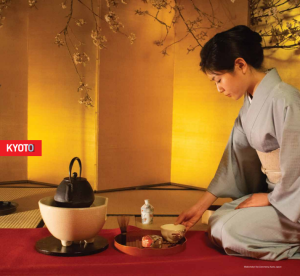
OSAKA
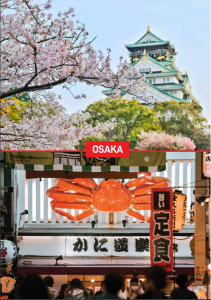
Osaka, the second largest city in Japan, is the final stop in this five-city tour of Japan. Getting from Kyoto to Osaka is a breeze as the cities are very close to each other. Taking the Shinkansen from Kyoto Station to Shin-Osaka Station takes a mere 15 minutes. If you have not done your shopping in the other cities (especially Nagoya), Osaka represents a great (and final) chance to catch up on your shopping needs. In terms of accommodation, basing yourself at Shin-Osaka Station or Osaka Station would not be amiss.
Umeda is the area where Osaka and Osaka-Umeda Stations are closely located together. This is the downtown area of Osaka and it is the right place to start your shopping spree. Osaka Station itself is linked to the huge Osaka Station City. The North Gate and South Gate Buildings are home to the LUCUA and Daimaru department stores respectively. Each store has over 10 levels of shopping to satisfy your shopping appetite.
Opposite the station, there is also the Yodobashi-Umeda building, home to Yodobashi – one of Japan’s biggest electronics retailers. Again, there are close to 10 levels of shopping for you to go through, with a prominent focus on electronics. Nearer Osaka-Umeka Station, you will find The Grand Front and Hep Five, shopping complexes that will similarly dazzle (and perhaps overwhelm) you in terms of shopping choices.
Once you have had your fill of shopping, it is time to go for a spot of sightseeing again. As with most cities in Japan, a castle is always a good place to start! Osaka Castle is arguably Osaka’s most prominent historical landmark. It dates back to 1583 and has witnessed centuries of changes that take place in the city. The castle is located in the centre of the 106-hectare Osaka Castle Park and in order to get to this monument, take the Osaka Loop Line from Osaka Station to either Morinomiya or Osakajokoen Station – you will end up at different ends of the park.
Morinomiya Station is located closer to the end where the Osaka Museum of History is located. This museum documents the rich history of the castle and is a must-visit if you wish to find out more about Osaka Castle. If you happen to visit during spring or autumn, you will also be treated to the beautiful sight of cherry blossoms, apricot and plum trees blooming. During this time, you will see plenty of locals picnicking in the park and enjoying the beautiful scenery.
If you fancy something quirky and unusual during your time in Osaka, you can make your way down to the Cupnoodles Museum (Osaka Ikeda). To get to this unusual museum, take the Hankyu-Takarazuka Line from Osaka-Umeda Station to Ikeda Station. The museum is located two blocks away from Exit 2.
There are a number of things you can do at the Cupnoodles Museum. Taking a walk through the Instant Noodles Tunnel, you will see around 800 products on display from the father of instant noodles – Nissin Foods. You can also make your own special cup of noodles, where you can create your own package design and customise your ingredients.
If you have children or are in the mood for a jolly good time at a theme park, you can make your way down to Universal Studios Japan for a rolling-coasting good time. From Osaka Station, take the Osaka Loop Line to Nishikuj Station and transit to the JR Yumesaki Line, alighting at Universal City Station.
As each Universal Studios theme park has its own unique set of rides, you will be getting a whole new experience that is different from Universal Studios Singapore. Here, at Universal Studios Japan, the rides and experiences include Super Nintendo World, Detective Conan: The World and Doraemon, characters and themes that are native to Japan. A visit to Universal Studios Japan can easily take up to a half or full day.
While you are in the area, make your way down to the nearby Osaka Aquarium Kaiyukan as well. From Universal Studios, take the Captain Line rapid ferry which will take about 10 minutes to reach the aquarium. Osaka Aquarium Kaiyukan is home to over 30,000 sea creatures spanning 620 species. The aquarium’s colossal viewing tanks practically recreate what it feels like to be immersed in the Pacific Ocean habitats.
You will begin your tour of the aquarium from the eighth storey, where the visitor trail spirals downward around the aquarium’s spectacular main tank. Here, you will get to see whale sharks, rays, sea lions and penguins at close quarters. Besides the gargantuan main tank, you can also take a stroll through the surrounding Tempozan Market as well as take a ride on the giant Ferris wheel outside the aquarium for a magnificent panoramic view of the Pacific Ocean.
REVISITING JAPAN
The list of cities listed in this article as well as the attractions highlighted in each city are by no means exhaustive, but they serve as a good introduction to certain places in Japan that are often neglected by Singaporean travelers. If you are game to go off the beaten track, use this article as a guide to lead you to new Places in the (Land of the Rising) Sun.











